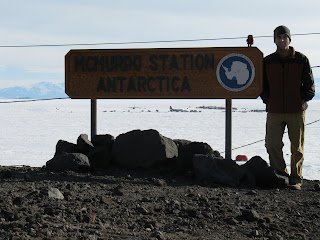Meet Mr. Adelie Penguin
Live Footage!
Greetings everyone from the icy shores of Cape Royds here in Antarctica. Yesterday we had the great pleasure of being invited on a trip from McMurdo up to Cape Royds where there is an Adelie Penguin rookery (colony).
First, let me show you where we went. The main town of McMurdo Station, while in Antarctica, is actually located on small island off of the mainland continent. It is, in a sense, connected to that mainland by the ice. Take a look:
Here's an overall map of Antarctica (click to enlarge)
Ross Island is located at the end of the Ross Ice Shelf, and across from the Transantarctic Mountains.
Zooming in on Ross Island, this is what it looks like, and where we drove to get up to Cape Royds to see the penguins:
Ross Island (click to enlarge)
You'll see on the map both McMurdo Station and Cape Royds. To get to Cape Royds, we drove snowmobiles and a large snow vehicle called a Pisten-Bully on top of the frozen sea ice (along the red line path in the picture above).
SO...Here's a quick recap of the day!
First we headed out, and I rode on a sled being towed by a snowmobile
Followed by another snowmobile and the Pisten-Bully
Then.....one of our snowmobiles brokedown and we had to leave it. (We picked it up later on the way back)
First stop: Cape Evans and Scott's "Terra Nova" Hut. In 1910 British Explorer Robert Falcon Scott set out on his Terra Nova Expedition to be the first to reach the South Pole. On January 17th, 1912 when his expedition party finally reached the the pole, they realized that their rival, Norwegian Roald Amundsen, had beaten them by 33 days, claiming the honor for Norway. The inside of the hut has been preserved and left untouched to look exactly as it did in 1912.
Terra Nova Hut
Inside the hut
Photo of Scott's party from 1912, taken at the South Pole
Next Stop: Barne Glacier Front!
After leaving Cape Evans, we passed by the calving front of Barnes Glacier and took some really nice photographs. The calving front of a glacier is its front end, or "terminus" where giant chunks of ice can break off and fall away. You don't want to be too close when that happens!
Enormous Glacier Front (nearly 100 feet tall)
The small black dot at the bottom is actually an enormous Weddell Seal
This should give you an idea of the scale.
Next Stop: Cape Royds and Shackleton's Hut
We made it up to Cape Royds and took the short walk over to another historical Hut: Ernest Shackleton's Hut. Between 1907 and 1909, Shackleton led a small party from Cape Royds on an attempt to reach the South Pole. This expedition, called the Nimrod Expedition, came up short and Shackleton's party never made it to the pole. They did however make it within 97 miles which was the farthest south anyone had been at the time. Of course 3 years later, both Amundsen and Scott's expeditions broke that record by making it to the pole.
Shackleton's "Nimrod Expedition" Hut
Shackleton's Party making it to the "farthest south"
point just 97 miles from the South Pole in 1909
Final Stop: Cape Royds Penguin Rookery!
Right across from Shackleton's Hut was the Penguin rookery. There were hundreds of Adelie penguins all hanging out in groups. There are 38 colonies of Adelie penguins around Antarctica and there are over 5 million Adelies around Ross Island alone!
Lots of Penguins!
More Penguins!
Taking a stroll
Hundreds more!
Two penguins showing off
ADELIE PENGUIN VIDEOS
FROM CAPE ROYDS TRIP!
(Click to Play)
This is as close as I was allowed to get to the penguins
The open water was just on the other side of
Cape Royds. It's a good thing we parked our
Snowmobile and Pisten-Bully on the other side!
There were also some Skua birds nearby. Skuas are
basically very large brown seagulls. They are not afraid
of people, and will actually try to steal food from you.
We also saw a mother Weddell Seal and her pup on the
Return trip back to McMurdo.
The Weddell Seal can weigh up to 1000 pounds and lives farther south than any other mammal on Earth!
Here's another photo I took of a Weddell Seal

















































